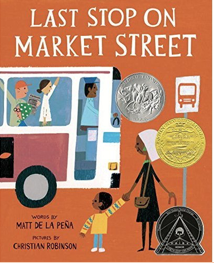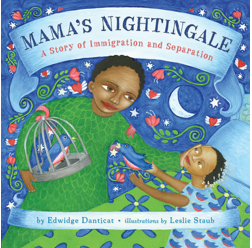 “Children’s books are safe containers to discuss any number of difficult topics with their caretakers or loved ones. They create opportunities for children seeking understanding and solutions for real-life issues to know they are not alone and to speak their truth. They open spaces for children to develop empathy and understanding and to feel pride in their cultural heritage and experiences.” - Javaka Steptoe, 2017 Caldecott Medal Acceptance Speech
“Children’s books are safe containers to discuss any number of difficult topics with their caretakers or loved ones. They create opportunities for children seeking understanding and solutions for real-life issues to know they are not alone and to speak their truth. They open spaces for children to develop empathy and understanding and to feel pride in their cultural heritage and experiences.” - Javaka Steptoe, 2017 Caldecott Medal Acceptance Speech
 “But what if I can nudge a few of these kids toward the magic of books at a younger age? What if I can write a story that offers that tough, hoodied kid in the back of the auditorium a secret place to feel?”
“But what if I can nudge a few of these kids toward the magic of books at a younger age? What if I can write a story that offers that tough, hoodied kid in the back of the auditorium a secret place to feel?”
- Matt de la Peña, 2016 Newbery Award Acceptance Speech
“What are the mentor texts for this unit?” was one of the first questions teachers asked in our planning meeting for our literacy units for the start of the 2017 school year. We started asking this in June, continued through summer conversations, and revisited this the day before the first day of school. “Can you recommend what books I should have out in my classroom library?” was another question I got that same week. I begin this blog post with words from award winning and inspiring authors, Matt de la Peña and Javaka Steptoe because they have helped me on this journey. Along with authors I follow from the We Need Diverse Books organization (and #WNDB on twitter) and recommendations from teachers and students across schools and social media, Matt de la Peña and Javaka Steptoe’s words remind us of the urgency and intention of our reading choices and available texts in our classroom libraries.
First, we must consider the children in our classrooms and how our text selection helps them see themselves as well as see beyond their experiences. The WNDB campaign mission is one way to consider our stance on diverse texts. Another way to approach this is using the Classroom Library Questionnaire by multicultural book publisher, Lee and Low. We can meet with colleagues during a grade team meeting and share or even engage students with a Cultural Relevance Rubric. Whether we do this with our set of mentor texts for a unit or a section from our classroom libraries, this is a helpful practice that considers the full human experience of the children in our classrooms.
Next, we must plan purposeful ways to integrate these texts in our instruction. For example, at one school during our back to school literacy planning, we selected 4-6 read aloud texts that are used across the unit as mentor texts for both reading and writing lessons. Some of the texts have powerful examples of narrative moves (Snowy Day by Ezra Jack Keats and Come On, Rain by Karen Hesse for precise words lessons). Others are great for leads and endings and excerpts of these are used for shared reading across the week.
 Finally, we must continue to provide spaces for children to engage these texts outside of the confines of reading and writing strategies. In other words, taking inspiration from Alfred Tatum’s work on textual lineages, children should have meaningful experiences with texts, noticing how these speak to their lives. Maybe this means taking those first days of school surveys, along with conversations with family/guardians, and using this information in putting together text sets or lists of texts that follow from these interests and those that you read during read alouds. Maybe this means providing discussion time at the end of interactive read alouds to discuss big understandings or life lessons. Reading Mama’s Nightingale: A Story of Immigration and Separation by Edwidge Danticat with my own students at the start of the semester was a profound experience. I hope your read alouds and texts in your classroom library provide students with these kind of meaningful moments.
Finally, we must continue to provide spaces for children to engage these texts outside of the confines of reading and writing strategies. In other words, taking inspiration from Alfred Tatum’s work on textual lineages, children should have meaningful experiences with texts, noticing how these speak to their lives. Maybe this means taking those first days of school surveys, along with conversations with family/guardians, and using this information in putting together text sets or lists of texts that follow from these interests and those that you read during read alouds. Maybe this means providing discussion time at the end of interactive read alouds to discuss big understandings or life lessons. Reading Mama’s Nightingale: A Story of Immigration and Separation by Edwidge Danticat with my own students at the start of the semester was a profound experience. I hope your read alouds and texts in your classroom library provide students with these kind of meaningful moments.
Please comment below with some inspiring moments from your classroom around reading experiences, your favorite texts, authors and classroom library tips!
